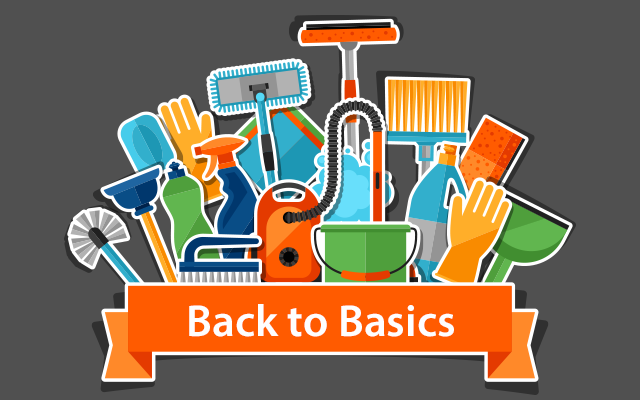Back to Basics: 10 Essentials of a Janitorial Closet
Today we thought it might be useful to go back to the basics and discuss high-quality, classic cleaning tools that show no signs of going out of style. Here are our picks for the 10 must-have items for every janitorial closet.
1. All-purpose cleaner
This cleaning solution packs the most bang for the buck because it can be used on a wide variety of surfaces for spray cleaning or floor mopping. Most products are effective on walls, countertops, glass, tile, and more. Certain chemical compositions will have limitations, so check the label or talk to your distributor before choosing the right product for your needs.
2. Disinfectant
To truly prevent the spread of infection, you’ll need more than a cleaner. A disinfectant kills 99.999% of germs within 5 to 10 minutes. It’s a mandatory product in healthcare, but disinfectant should be used in all facilities, particularly during cold and flu season. Make sure the product you choose is compatible with your cleaning tools and has a shorter dwell time.
3. Cleaning cloths
After spraying a cleaning chemical, the janitor needs a tool to remove it (and the soil it’s being used to eliminate). Cleaning cloths are one of the most-used custodial tools, so it’s not an area for skimping. Experts say most facilities, especially those most concerned with infection prevention, should spend extra for microfiber cloths rather than cheap cotton rags. The synthetic fibers are incredibly absorbent and can pick up soil more quickly and efficiently than cotton.
4. Bowl cleaner and brush
No one loves cleaning toilets and urinals, but it’s an essential part of any housekeeping task list. Keep the restroom sanitary by providing janitors with acid bowl cleaners to descale the insides of the fixtures to remove hard water and mineral stains. Long-handled toilet brushes allow them to properly scrub a toilet without getting their hands or faces too close for comfort.
5. Mop and bucket
Janitors should always have access to mops and buckets available because even in very large buildings there are areas where large autoscrubber simply isn’t effective. A simple mop and bucket can be easily maneuvered around fixtures and furniture to clean tight spaces quickly. Again, flat microfiber mopping systems are a worthwhile upgrade because, in addition to being more effective and eco-friendly, they offer ergonomic benefits.
6. Autoscrubber
Unless you clean only very small buildings with nothing but carpet, you’ll benefit from having at least one autoscrubber in your equipment fleet. Even the smallest 17-inch machine can clean 3 times more square footage of hard-surface floors per hour than a standard mop. To make the most of your capital investment, choose an appropriately sized machine (from small walk-behind to large ride-on) and with only as many features as you’ll actually use. Corded machines typically cost less than battery-operated ones, but have a more limited coverage area.
7. Vacuum
Primarily designed to keep carpets safe, vacuums can often also be used on hard floors. There are a wide range of vacuums available to suit every facility, from compact uprights to cordless backpacks to ride-on sweepers for very large corridors. Whatever style you choose, make sure it comes with all the attachments your staff needs to be effective, such as those for cleaning upholstery or for high and tight spaces.
8. Extractor
You’ll need more than a vacuum for proper carpet care. Extraction removes built-up dirt and soil before it penetrates the fibers and destroys the carpet. At least twice a year—and more frequently in high-traffic areas—use a carpet extractor for deep cleaning. Available in portable, self-contained, and truck-mount styles, the machines inject a water-solution mixture into the carpet and then suck it (and soils) up.
9. Floor safety tools
Slip-and-fall accidents are serious business, costing about $60 billion each year in worker’s compensation claims and liability awards. In addition training staff on proper cleaning techniques, managers should invest safety products designed to protect workers and building occupants. A few hundred dollars for air movers, wet-floor signs, and entrance matting is small change compared to just one worker’s comp claim at an average cost of $4,000.
10. Personal protective equipment
It’s a manager’s job to keep his staff safe (it’s also a requirement by the Occupational Safety and Health Administration). That’s why every janitor’s cart should include basic PPE: Rubber gloves, goggles or face shields, and respirators to protect the hands, eyes, and lungs from exposure to harsh cleaning chemicals.

